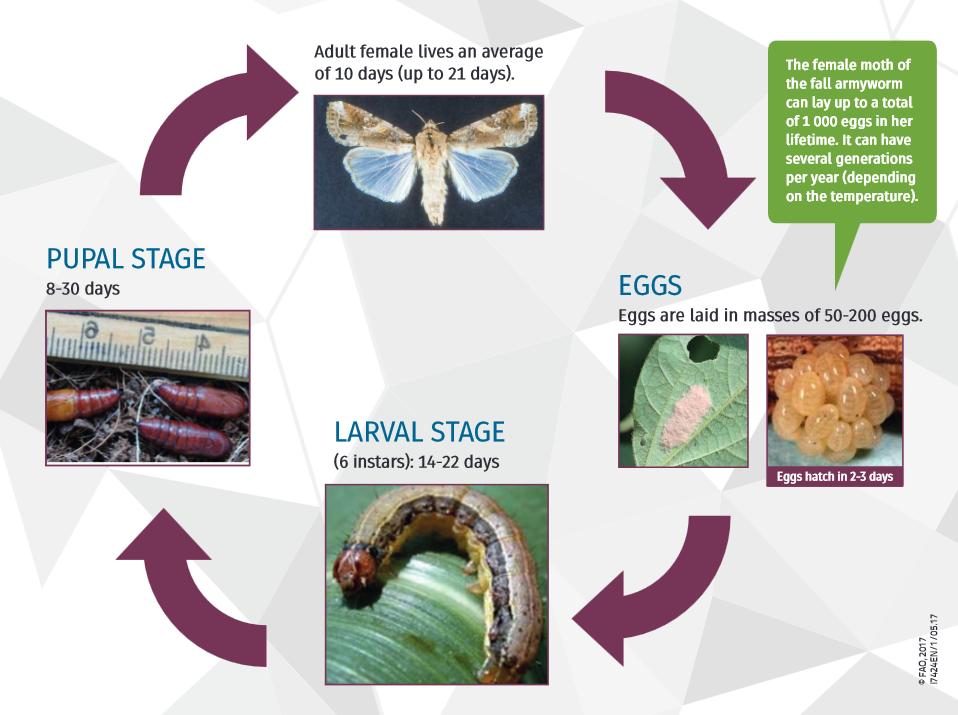Fall Armyworm
Fall Armyworm
Fall Armyworm (FAW) (Spodoptera frugiperda) is an insect pest that feeds on more than 80 crop species, causing damage to economically important cultivated cereals such as maize, rice, sorghum, and also to legumes as well as vegetable crops and cotton. It is native to tropical and subtropical regions of the Americas. High infestations can lead to significant yield loss.
About FAW
The adult moth is able to move over 100 km per night. It lays its eggs on plants, from which larvae hatch and begin feeding. The female moth can lay up to a total of 1 000 eggs in her lifetime. The eggs of FAW are white in color and later turn into brown. They hatch in 2-3 days. The larvae has six stages initially are brown in color and later turn into dark green. FAW larvae are seen in groups. The larva of FAW can be identified by four characteristic spots on the last second segment forming a square. The head has an inverted “Y” mark.
The larva is the damaging stage of the insect. It generally prefers corn (maize), and can attack millet, vegetables, rice, sugarcane and sorghum. Due to the strong flying ability, it has spread to most of the tropical countries and has entered even India. If the eradication of the pest is delayed, it can cause huge loss to crop yield.

Integrated Pest Management of FAW
IPM is an integrated strategy of pest control which aims at prevention of pests and its damage through a combination of techniques such as chemical, biological, new cropping system, modification of cultural practices, use of resistant varieties and through mechanical methods.
IPM emphasizes the growth of a healthy crop with the least possible disruption to agro-ecosystems and encourages natural pest control mechanisms.
- Seed treatment and use of resistant varieties : Treating the seeds with recommended pesticides especially biopesticides will help in reducing the early damage of the seedlings and laying of egg masses. Cultivation of resistant varieties is also an effective management technique.
- Crop management : One of the best method with zero input cost is through the crop management practices. Going for early planting and avoiding late planting and staggered planting will reduce pest incidence. Good soil health and adequate moisture help to raise a healthy crop which can withstand infestation. Unbalanced fertilizer application especially high nitrogen application will increase the oviposition of the insect. Keeping the field clean and managing the crop residue will improve the crop.
- Cropping system : It is observed that the infestation is more in monocropping of maize. Growing inter crops like legumes will reduce infestation. Certain flowering plants like Coriander, Marigold, Fennel, etc attract beneficial insects which are natural enemies. Trees also plays a major role as they harbor birds which are natural enemies. The "PUSH-PULL" strategy is a habitat management in which a repellent crop or attractive trap crop is grown to repel pests and attract natural enemies.
- Mechanical control : It is very important and generally followed in small holdings. Collection and destruction of egg masses and young larvae can be taken up. Application of sawdust or sand into the whorls leads to the aberration and desiccation of the young larvae. Use of traps, bird perches can also be taken up.
- Biological control: Naturally existing enemies act as bio control agents. Parasitoids come under this category. These parasitoids lay eggs on egg masses, larvae or adult of FAW which destroys the host by growing on them.
Parasitoid
Nature
Telenomus remus Nixon
Females are egg parasitoids
Chelonus insularis Cresson
Females are ovo-larval parasitoid
Cotesia marginiventris Cresson
Females are solitary larval parasitoid
Trichogramma spp.
Females are egg parasitoids
Archytas, Winthemia and Lespesia
Females lay egg on adult
Ladybird beetles
Phytophagous in nature
Calosoma granulatum
Feeds on young cater piller
- Entomopathogens : Generally pathogens like bacteria, fungi and virus affect the yield of the crop. But some microorganisms are beneficial to farmers. In this NPV’s come first especially Spodoptera Frugiperda Multicapsid Nucleopolyhedrovirus (SfMNPV). Some fungi include Metarhizium anisopliae, Metarhizium rileyi, Beauveria bassiana, bacteria such as Bacillus thuringiensis (Bt).
- Biopesticides : Bio pesticides are the pesticides that are biological in origin. Generally the formulations are derived from specific strains of bacteria, fungi or virus. For FAW Beauveria bassiana strain R444, Bacillus thuringiensis subspecies kurstaki strain SA-11, Baculovirus, SFMNPV - Baculovírus Spodoptera frugiperda are found effective.
- Botanicals : Botanicals are the natural chemicals which are of plant origin. Botanicals are generally with broad spectrum activity with no or minimum effect on mammals. They act as repelling agents, larvicidal or antifeedants. Extracts from neem seed or leaves, Pyrethrin from Chrysanthemum cinerariifolium and rotinoids from Tephrosia vogelii are found effective against Fall Army Worm.
- Chemical pesticides : Chemical pesticides are artificially manufactured compounds which have mammalian toxicity and toxic to beneficial organisms. They have residual effect and create damage to ecosystem. Generally, the chemicals like Methomyl, Cyfluthrin, Methyl parathion, are sprayed against FAW.
References
Authors
- Madhu Kiran Tumma, PBRD Asia-Pacific Millet India, Pioneer Hibrid Pvt Ltd., Hyderabad 500082
- K S V Poorna Chandrika, ICAR-Indian Institute of Oilseeds Research, Rajendranagar, Hyderabad, Telangana 500030
Last Modified : 6/27/2023
This topic covers information about Identification...
Package of Practice (POP) for the management of Fa...
